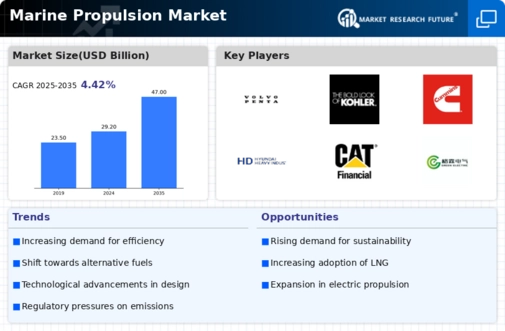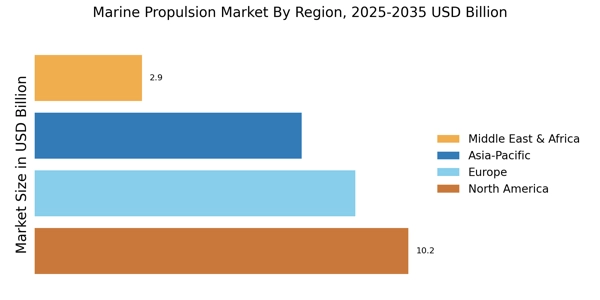Expansion of Maritime Trade Routes
The Marine Propulsion Market is benefiting from the expansion of maritime trade routes, which is facilitating increased shipping activity. The development of new trade agreements and the opening of previously inaccessible routes are driving demand for marine vessels equipped with advanced propulsion systems. This expansion is expected to lead to a rise in the number of vessels in operation, thereby increasing the need for efficient and reliable propulsion technologies. As a result, manufacturers in the Marine Propulsion Market are likely to focus on enhancing their product offerings to cater to this growing demand.
Investment in Renewable Energy Sources
The Marine Propulsion Market is increasingly focusing on investment in renewable energy sources as a means to enhance sustainability. The shift towards renewable energy, such as wind and solar power, is influencing the design and operation of marine vessels. Companies are exploring hybrid systems that combine traditional propulsion with renewable energy sources to reduce reliance on fossil fuels. This trend not only aligns with The Marine Propulsion Industry. As more stakeholders recognize the potential of renewable energy, the market is likely to evolve rapidly.
Growing Demand for Efficient Shipping Solutions
The Marine Propulsion Market is witnessing a growing demand for efficient shipping solutions driven by the increasing volume of global trade. As economies expand, the need for reliable and cost-effective transportation of goods is paramount. This demand is pushing shipping companies to seek advanced propulsion systems that offer better fuel efficiency and lower emissions. According to industry reports, the market for marine propulsion systems is projected to grow at a compound annual growth rate of approximately 4.5% over the next five years. This trend indicates a robust opportunity for innovation and investment in the Marine Propulsion Market.
Technological Advancements in Marine Propulsion
The Marine Propulsion Market is experiencing a surge in technological advancements, particularly in engine design and fuel efficiency. Innovations such as hybrid propulsion systems and advanced engine control technologies are becoming increasingly prevalent. These advancements not only enhance performance but also contribute to reduced operational costs. For instance, the integration of digital technologies in propulsion systems has been shown to improve fuel efficiency by up to 15%. As a result, stakeholders in the Marine Propulsion Market are likely to invest heavily in research and development to stay competitive and meet regulatory standards.
Regulatory Compliance and Environmental Standards
The Marine Propulsion Market is significantly influenced by stringent regulatory compliance and environmental standards. Governments and international bodies are imposing regulations aimed at reducing emissions from marine vessels. The International Maritime Organization has set ambitious targets for reducing greenhouse gas emissions, which has prompted shipbuilders and operators to adopt cleaner propulsion technologies. This shift is expected to drive the demand for alternative fuel systems, such as LNG and hydrogen, which are gaining traction in the Marine Propulsion Market. Consequently, companies that proactively adapt to these regulations may gain a competitive edge.


















Leave a Comment